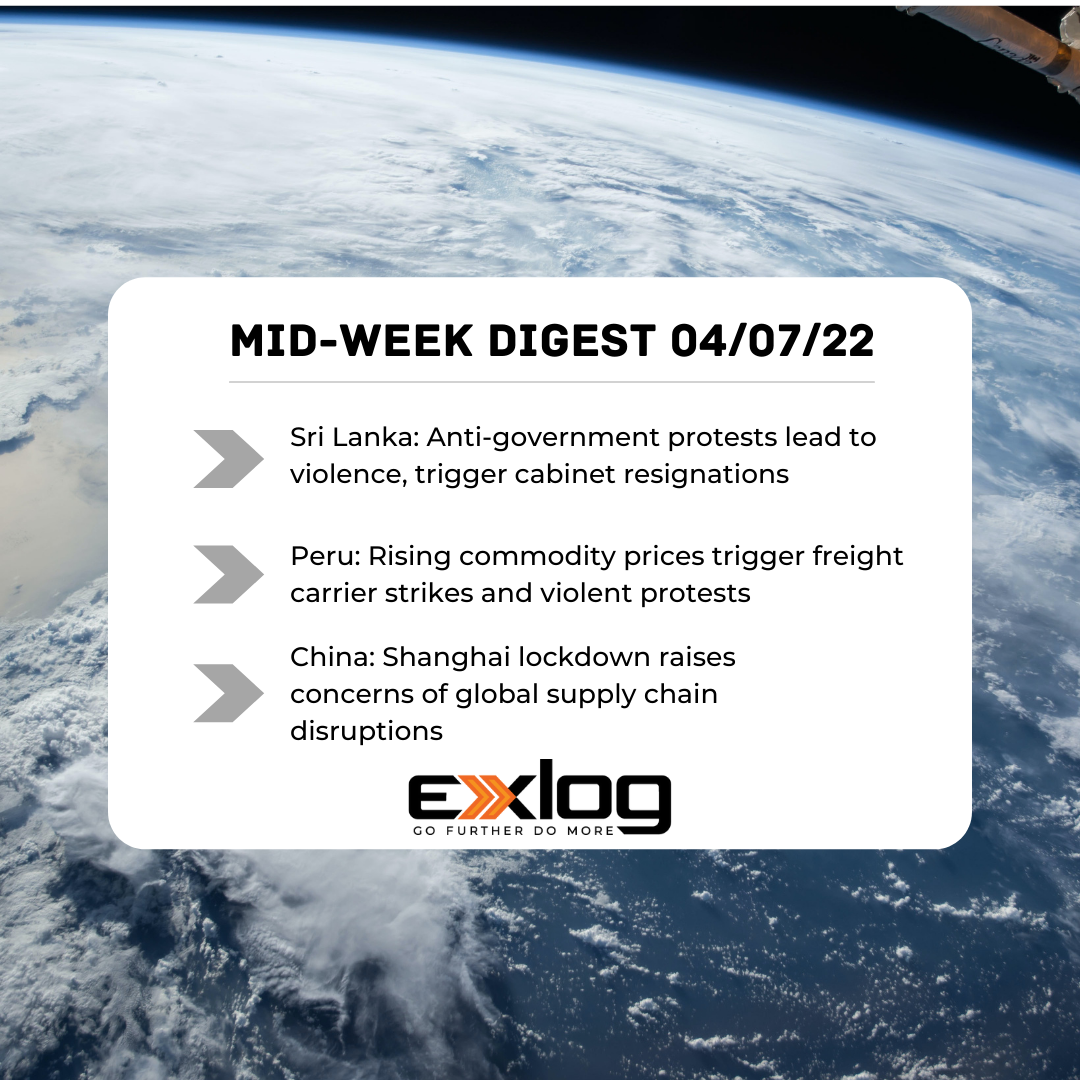Anti-government rallies sweep Sri Lanka, Transportation workers strike in Peru, and Lockdown in Shanghai
Sri Lanka: Anti-government protests lead to violence, trigger cabinet resignations
Thousands of Sri Lankans demanding the resignation of the President Gotabaya Rajapaksa have taken to the streets to protest a worsening economic and energy crisis. Widespread civil unrest prompted the government to declare a public emergency and sparked mass resignations from Sri Lanka’s cabinet on April 3. Sri Lankans have been organizing small-scale demonstrations over economic grievances throughout March but the protests intensified when the government announced a 13-hour power outage on March 31, prompting hundreds to mobilize in the vicinity of the President Gotabaya Rajapaksa’s residence in Mirihana – located approximately 10 km (6.2 mi) outside Colombo. The demonstration turned violent when security forces deployed tear gas and used a water cannon to disperse the crowd, prompting the protesters to retaliate by throwing stones and setting fire to buses used by security forces. At least 24 police officers were injured while 53 people – including eight journalists – were arrested. As a response to the protest, the government temporarily blocked access to Facebook, YouTube, Twitter and other social media platforms used to organize protests and implemented a nationwide 36-hour curfew that was lifted on the morning of April 4. However, numerous sporadic demonstrations were reported across the country despite the emergency measures, with the majority of the protests occurring in Western Province – including its largest city, Colombo – where 664 people were detained for violating movement restrictions in the first 12 hours of the curfew. In Colombo and Kandy – a city about 144 km (90 mi) east of the capital – protesters clashed with security forces outside several former ministers’ official residences. Following the cabinet resignations, President Rajapaksa suggested forming a unity government but the main opposition parties rejected the proposal. While the president has reappointed several of the outgoing ministers, the cabinet reshuffle has done little to quell demands that he step down. An economic crisis and shortages of basic goods has overwhelmed Sri Lanka, with inflation reaching record 18.7% in March and food prices rising by 30.1%. In the absence of adequate foreign currency reserves to import essential goods, shortages of medicine, fuel and food – as well as lengthy power shortages – will persist. If the president steps down, he will lose his legal immunity – which seems an unlikely scenario due to several investigations into him and his family – indicating that protests are likely to continue in the short term.
Peru: Rising commodity prices trigger freight carrier strikes and violent protests
Nationwide transportation worker protests over inflation and rising fuel and fertilizer prices have entered a second week and continued to escalate across the country despite the government’s attempts to appease protesters by removing the fuel tax and increasing the minimum wage over the weekend. Demonstrators have blocked key transportation routes in at least six regions – Piura, San Martín, Ucayali, Amazonas, Ica and Lima – obstructed access to water distribution centers and have attacked other workers who refuse to join the strike. At least four people have died in protests in Huancayo – located 304 km (188 mi) east of Lima – and more than 22 demonstrators have been detained. Bus drivers and farmers joined the strike on April 4, blocking major roadways and highways (including the Pan-American Highway), vandalizing toll booths and businesses and engaging in confrontations with security forces in at least 13 regions, including Ica and Huancayo. Widespread civil unrest prompted President Pedro Castillo to declare a State of Emergency (SOE) and an all-day curfew from 0200-2359 in districts of Metropolitan Lima and Callao on April 5. However, numerous protests erupted in the city after the president lifted the curfew at around 1800. Several of these incidents turned violent near Plaza San Martín and various government buildings in central Lima as protesters clashed with security forces and looted commercial establishments; at least 30 people – including 25 police officers – were injured, while eight others were detained during overnight protests. As of April 6, protests are ongoing in downtown Lima and other parts of the country. Clashes between protesters and police forces in Ica left at least one protester dead and several policemen injured; demonstrators also held two police officers hostage at a highway station outside Ica, demanding the release of previously arrested activists. The conflict in Ukraine will continue to drive up fuel and fertilizer prices while roadblocks will likely disrupt supply chains, contributing to a further increase in prices for various goods. In the absence of a comprehensive government solution to improve the current economic climate, protests will likely persist in the short to medium term.
China: Shanghai lockdown raises concerns of global supply chain disruptions
The Chinese government implemented an abrupt, staggered lockdown in Shanghai on Mar. 28 in response to a surge in COVID-19 cases – from near-zero to 5,000 cases daily – sparking fears of severe disruptions to both the local economy and international supply chains. The authorities staggered the stay-at-home orders by geographical location, instructing citizens residing in the city’s eastern Pudong district to self-isolate from March 28 – April 1, while residents of the western Puxi district were required to self-isolate from April 1-5. The government claimed that these two four-day isolation periods would be used to test all 26 million of Shanghai’s residents, with the goal of successfully locating and quarantining all symptomatic and asymptomatic carriers of the virus. The two-stage lockdown was intended to limit the social and economic toll by ensuring that at least half of the city remained operational. However, an indefinite extension of the stay-at-home order announced on April 4 will likely exacerbate the economic impact to local businesses and international companies operating in the city. At the start of the lockdown, public transport was suspended while businesses and factories in Shanghai were instructed to halt operations or require employees to work remotely. Experts predict that even a short-term closure of local stores, hotels, and restaurants could lead to a 3.7% decrease in the city’s GDP. Many international companies with offices in the city have been forced to cease operations, while a few others have been permitted to remain open under the caveat that employees live on-site while the lockdown is in effect. While the Port of Shanghai – the largest seaport in the world – has remained operational, port congestion levels have soared, resulting in shipping delays and a sharp increase in freight and transportation costs. Unlike its maritime logistics infrastructure, the financial sector in Shanghai has yet to see any significant impacts. The Shanghai Stock Exchange remains open, and many financial companies have been able to operate remotely or recruit employees to temporarily reside in the office. While the combined effects of the lockdown in Shanghai could lead to far-reaching supply chain disruptions, experts argue that most businesses have adapted to frequent pandemic-related disruptions across China. Various contingency plans include utilizing different shipping ports, diverting available freight to warehouses unaffected by lockdowns, and preemptively stocking factories and offices with supplies for employees choosing to live and work in the buildings. However, if the lockdown continues for an extended period of time, the probability of severe short- and long-term economic impacts – including product shortages and inflated transportation costs – will likely increase.


